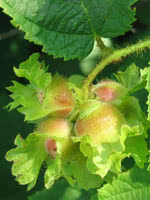Mon-Fri 9am - 5pm Mountain time
Western Snowberry vs American Hazelnut/Filbert
Corylus americana
Symphoricarpos occidentalis
NOT AVAILABLE THIS SEASON - MIGHT RETURN
NOT AVAILABLE THIS SEASON - MIGHT RETURN
American Hazelnut is a cold hardy, disease resistant, and long-lived nut tree. It is a great choice for a shrub border for wide, open spaces where it will be allowed to spread. Typically used in naturalization projects for its spreading nature, American Hazelnut is ideal for our zone 4 customers.
If you're a zone 3 prairie customer, don't worry! American Hazelnut can still thrive but needs additional care and protection from our harsh prairie climate.
The edible nuts mature from September to October and are usually roasted or eaten fresh. Make sure you take time to notice American Hazelnut's variable and beautiful fall color that ranges from orange, rose, purplish-red, yellow, and green.
Note: You want more than one hazelnut to improve yields.
Like the Common Snowberry, the Western Snowberry is a small shrub with pink flowers useful for feeding livestock and preventing erosion. Unlike the common species, however, the Western Snowberry is much more suited to wet conditions, capable of persevering through poor soil drainage and occasional flooding.
After the Snowberry's flowers have bloomed, it produces berries which often last on the plant through winter. These berries are toxic to humans, but livestock and local wildlife love them! Those hoping to attract wildlife to their property can plant Snowberry and expect to see animals foraging on it much later in the year than other plants.
American Hazelnut/Filbert Quick Facts
Western Snowberry Quick Facts
Toxicity: berries are toxic to humans

